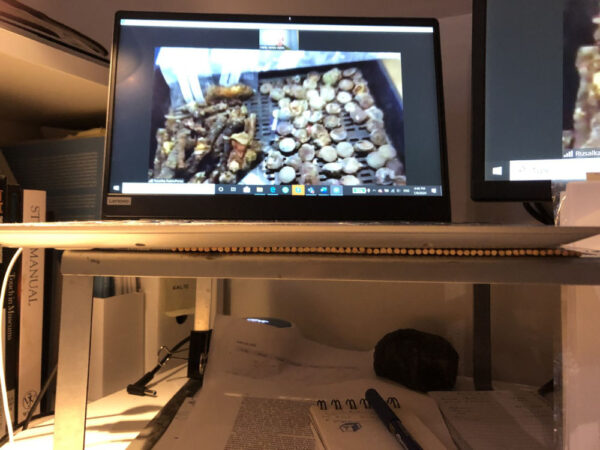What do I mean by Zoom to the rescue? The best way to explain this is to give some background to how artefacts change underground and how excavation and preservation of historical archaeological artefacts proceed in Victoria.
Responding to recently excavated archaeological materials is called first-aid. Artefacts undergo an increase in their rate of deterioration when they are discarded (or purposefully covered) before settling into a period in which they become one with the environment in which they are buried. At the time of excavation, when their environment changes, artefacts can rapidly deteriorate in response to this change – they might shrink, collapse, disintegrate or even on rare occasions spontaneously explode. In archaeological conservation, first-aid includes any step taken to ensure the artefact survives, from its discovery until it undergoes further conservation.
During the COVID-19 pandemic, building construction is an essential activity in Melbourne. Thus, archaeological excavations on historical sites have also continued. By historical I mean colonial-settler, not Indigenous Australian. Archaeological excavations at historical Melbourne sites are overseen by Heritage Victoria, a Victorian State Government agency responsible for administering the Heritage Act 1995 and supporting the work of the Heritage Council of Victoria. Before an excavation permit is awarded, archaeologists must have an ‘Artefact Management Proposal’ detailing how recovered artefacts will be managed in the field and post-excavation, in accordance with s129 (4b) of the Heritage Act. Essentially, excavations cannot go ahead without a conservator being engaged. The Heritage Act ensures that there is a practical framework in place to plan for and protect collections throughout an archaeological project. The Act provides a model that ensures artefacts are conserved and curated and are accessible for social use into the future.
Melbourne has been in lockdown for the best part of five months, and we have had to find ways to continue to provide first-aid services. That’s where our Zoom to the rescue comes in. Before COVID-19, I would have driven to the archaeological site or office to examine and triage objects. With these privileges denied we have undertaken first-aid using Zoom. My client shows me the objects via her computer camera, and I ask her a series of questions, relying on her senses of touch, sight and smell in place of my own. How heavy is it? Is it warmer or colder than your skin? Does it smell? From her answers, I determine how to triage the objects, and she learns how to use her senses to identify deterioration.


This has been a fun, practical and fantastic two-way learning process that I will continue to use after the lockdown. Undertaking first-aid using Zoom has improved our working relationships, built trust, and taught the archaeologist new skills in the area of conservation first-aid.
As stated by the archaeologist, COVID-19 has forced us to think laterally about how we manage artefacts. Devoting half an hour a week to ensuring their stability before being given to the analyst/conservator has been enlightening, saved time, built relationships and established new and effective processes (pers. comm. 2020, Rusalka Rubio Perez, Extent Heritage).